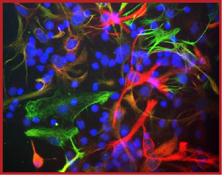
Anti-Nestin (NES)
Mouse Monoclonal Antibody
Catalog No. N122-561M
| Catalog No. | Pack Size | Price (USD) | |
|---|---|---|---|
| N122-561M-100 | 100 ug | $355 | |
| N122-561M-BULK | BULK | Contact Us |

Mouse Monoclonal Antibody
Catalog No. N122-561M
| Catalog No. | Pack Size | Price (USD) | |
|---|---|---|---|
| N122-561M-100 | 100 ug | $355 | |
| N122-561M-BULK | BULK | Contact Us |
Overview:
Nestin (NES) is a Nestin is a Class VI intermediate filament expressed in the developing central nervous system (CNS) in early embryonic neuroepithelial stem cells. This protein has been widely used as a predominant marker for stem / progenitor cells, glioma cells, and tumor endothelial cells in the mammalian CNS. Furthermore, it is a superior angiogenic marker to evaluate neovascularity of endothelial cells in tumor.
Specificity:
Recognizes the Nestin (NES) protein
Cross Reactivity:
Human and Rat
Host / Isotype / Clone#:
Mouse, IgG
Immunogen:
Recombinant human Nestin expressed in bacteria and highly purified. The specific region was amino acids 317 to 630 of the human protein. This is a region which is 55% identical to rat Nestin and 57% identical to mouse Nestin.
Purification:
Affinity chromatography
Stability:
Store at 4oC (add 0.1% NaN3) for several months, and at -20oC for longer periods. For optimal storage, aliquot target into smaller quantities after centrifugation and store at recommended temperature. For most favorable performance, avoid repeated handling and multiple freeze/thaw cycles.
Sample Data:
Western blot of developing rat brain (P18) homogenate probe with Anti-Nestin (NES) antibody. A single strong band is seen at ~240 kDa.

|
Sample Data:
Mixed cultures of neonatal rat neurons and glia stained with antibody- Nestin (red) chicken antibody to vimentin (green) and DNA (DAPI stain, blue). Astrocytes and neuronal stem cells stain strongly and specifically in a clearly filamentous fashion with the Nestin Antibody. The filamentous staining pattern is as expected as both Nestin and vimentin are components of 10nm filaments. Note that some cells contain Nestin, but do not stain strongly for vimentin and so appear red. Others contain vimentin and not Nestin and so appear green- these are likely to be fibroblastic or endothelial cells. Some cells express both proteins and so appear yellowish. The presence of nestin indicates that the cells are developing astrocytes, neuroblasts or undifferentiated neural stem cells.

|
There are no related publications available for this product.
Angiogenesis, Cancer, Neurobiology
STAY CONNECTED
Fax: 1-604-232-4601